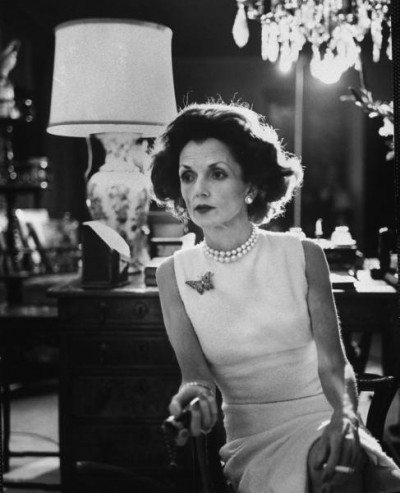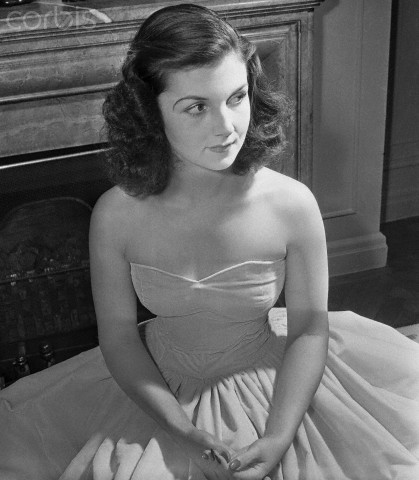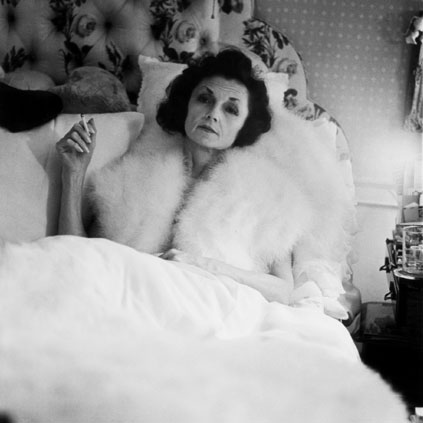Brenda Frazier (Brenda Diana Duff Frazier)

Frazier’s father, Frank Duff Frazier, came from a prosperous Boston family. Her mother, the former Brenda Germaine Henshaw Williams-Taylor, was the only daughter of Sir Frederick Williams-Taylor (a general manager of the Bank of Montreal who was knighted in 1910 and combined his middle name and birth surname into a new hyphenated surname) and his wife, the former Jane Fayrer Henshaw. Frazier’s parents were married in December 1916. Both of Frazier’s parents drank heavily. At the time of her birth, Frazier’s father went on an alcoholic bender and did not return home for months. After public fights and infidelity from both sides, the couple divorced in January 1926. In March 1926, Frazier’s mother married Frederick N. Watriss with whom she had been having an affair. After Watriss’ death, she married Henry Pierrepont Perry. Over the next eight years, Frazier’s parents fought over custody of Brenda. Both attempted to gain sole custody by accusing the other of immoral behavior, alcoholism and being an unfit parent. During the custody battle, she was largely ignored by both parents and spent the majority of her time at school (Miss Chapin’s School for Girls, Miss Porter’s School and a finishing school in Munich) or with her paternal grandmother. In 1933, a judge finally ruled that Frazier’s parents would share custody. The judge stated, “Neither parents appears to have been in the past, nor appears to be now, any paragon of virtue in parenthood.” A month after the decision was handed down, Frank Frazier died of throat cancer. Although Frazier had shown promise in music and art, she later lamented that she had never been given a chance to let those talents develop, or to complete her education. The year before her 1938 debut, she was attending a finishing school in Munich. She had begged her mother to let her stay there and continue to study, but her mother refused, and thus her formal education ended at the age of 15.
With her mother’s blessing, Frazier began appearing at café society functions and was regularly photographed and featured in the society pages of magazines and newspapers at the age of 12. By the time she was a teenager, the press and public began taking a keen interest in wealthy members of high society who had not lost their fortunes due to the Wall Street Crash of 1929. Readers who were living through Great Depression were eager to read about the lives of the wealthy and glamorous “Poor Little Rich Girls” such as Frazier, Gloria Vanderbilt, Doris Duke, and Barbara Hutton were frequently written about and photographed. The press eventually began calling them “Glamour Girls”. Frazier began to gain attention as a teenager after columnist Walter Winchell began writing about her. In 1936, two years before her society debut, society journalist Maury Henry Biddle Paul (known as Cholly Knickerbocker) wrote, “It may seem a bit early, but I – here and now – predict Brenda Frazier will be one of the belles – if not the Belle – of her season.” Cholly Knickerbocker’s prediction boosted Frazier’s profile and her upcoming debutant ball became one of the most anticipated social events of 1938.
Frazier was routinely photographed and popularized the famous “white-face” look; powdered white skin contrasted by red painted lips combined with perfectly coiffed dark hair (Frazier later said she suffered from neck problems because she rarely moved her head for fear of mussing her hair). During this time, Frazier developed anorexia and bulimia to keep her weight down. Both disorders would plague Frazier for the remainder of her life. In 1938, the year of her debut, Brenda Frazier was dubbed the #1 Glamour Girl. Later that year, in November 1938, she achieved the apex of fame—her face on the cover of Life magazine. The enclosed article inside gave hardly a mention of Frazier but from it she secured international fame. Frazier would go on to pose in ads for Woodbury soap and Studebaker cars (even though she could not drive) among others. Frazier’s debutant party was held on December 27, 1938 at the Ritz-Carlton in New York City. The party was attended by 2,000 people including Douglas Fairbanks, Jr. whom Frazier danced with. Despite being sick with the flu and having swollen feet, Frazier danced with Fairbanks, Jr. until 6:30 am.[6] Frazier later recalled collapsing into bed from exhaustion in the early morning hours and not being able to remember any of the day that followed. Frazier’s debutant party was a success and was featured on the front page of newspapers around the world. She was dubbed the “Debutante of the Century”. In 1939, the word celebutante, a portmanteaux of the words “celebrity” and “débutante”, was coined to describe Frazier.
However, not all of the attention Frazier and other heiresses received was positive. Some media outlets and critics commented that Frazier was only famous for being rich and possessed no discernible talents. Frazier would later recall being booed at a Broadway nightclub one evening after she was introduced to the audience alongside other celebrities such as Ben Blue and Sonja Henie. Although she felt humiliated afterward, she acknowledged that her critics were right insofar as she was not a true celebrity, only a debutante. Frazier later admitted that she was never truly happy as a debutante. She said there were times when she did relish the attention she received, but that she had never felt loved by either of her parents or valued as anything more than a status symbol or a trophy.[5] In the book Debutante: The Story of Brenda Frazier by Gioia Diliberto, Frazier’s daughter Victoria Kelly remembered her mother saying, “I’m not a celebrity. I don’t deserve all this. I haven’t done anything at all. I’m just a debutante.” Her family was equally dumbfounded. “I fear Brenda’s being spoiled,” said a great-aunt at the time of her great-niece’s debut. “I bemoan all this spectacular notoriety.” At the age of 21, Frazier inherited a total of $3,900,000 ($56.3 million today) from her father and her paternal grandmother, who died in 1936.
Frazier married football star Shipwreck Kelly at her mother’s apartment at the Ritz-Carlton in New York City on June 30, 1941. She gave birth to a daughter, Brenda Victoria, in 1945. Frazier and Kelly divorced in 1956. After several tempestuous relationships, including ones with cartoonist Peter Arno and Howard Hughes, Frazier and daughter moved to a small town near Cape Cod. On March 3, 1957, she married sales executive Robert Chatfield-Taylor. Frazier later told friends that she regretted marrying Chatfield-Taylor right away. They divorced in 1962.
On March 16, 1961, Frazier attempted suicide by overdosing on sleeping pills. She was discovered and survived the attempt but would make thirty more suicide attempts throughout her life. In 1963, she wrote a piece for Life magazine – the same publication on whose cover she had appeared 25 years earlier (although the cover of that week’s issue was given to the state funeral of the assassinated President Kennedy) – titled “My Debut – A Horror”. In the article, she related that she was largely unhappy during her debutante year and, after years of therapy, she looked at photos of the event and noted “the mockery of faked smiles…and how many people there are in the world who were doomed like me by unfortunate childhoods to adult lives plagued by fears and inner emptiness.” Frazier also detailed the many nervous breakdowns she suffered due to the negative attention she received and was also critical of her family for “being pushed into social functions.” The article sparked renewed interest in Frazier and she appeared on several talk shows where she discussed her experiences as a “celebutante”.
In her later years, Frazier retreated from public life and divided her time between her homes in East Harwich and Beacon Hill. She became reclusive and developed an addiction to drugs and alcohol. A friend later stated that Frazier took “…pills to go to sleep and pills to wake up, pills for digestion and pills to go to the bathroom, and pills to be happy and pills to be sad, and pills to be.” In 1966, photographer Diane Arbus took a now-famous picture of Frazier for Esquire magazine. The photo featured a gaunt Frazier heavily made up in her signature white face powder and red lipstick, propped up in bed with a cigarette in hand looking wearily toward the camera. During the final ten years of her life, Frazier suffered from ill health due to her long battles with anorexia and bulimia and was routinely hospitalized. On May 3, 1982, Franzier died of bone cancer at Newton-Wellesley Hospital in Boston at the age of 60.
§
Born
- June, 09, 1921
- Quebec, Canada
Died
- May, 03, 1982
- USA
- Boston, Massachusetts
Cause of Death
- bone cancer



